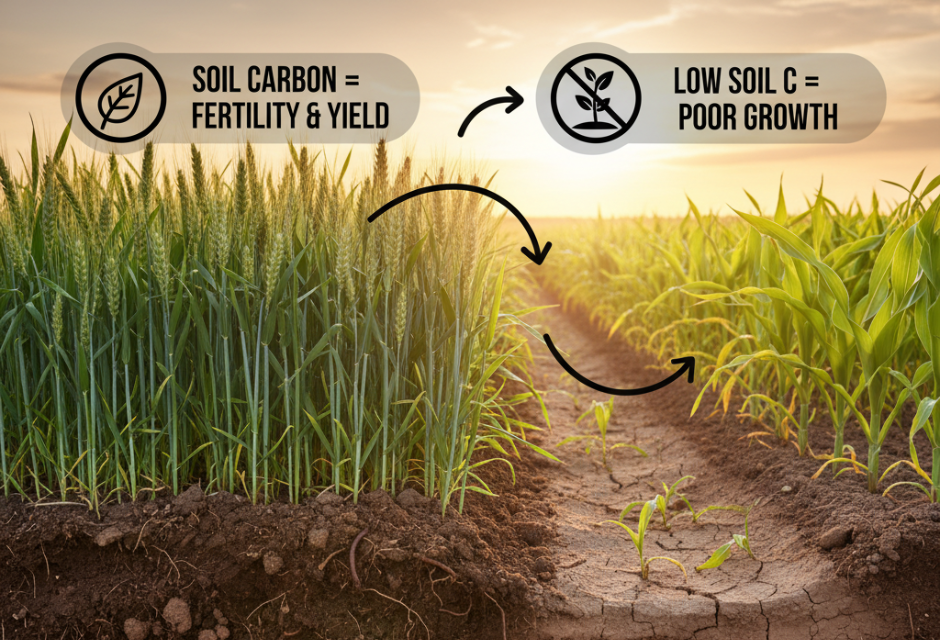Understanding Soil Carbon and Its Impact on Crop Productivity
- IRIS Hybrid Seeds

- Nov 12
- 4 min read
Updated: 4 days ago

Soil carbon plays a vital role in maintaining soil health and supporting sustainable agricultural productivity. As one of the largest reservoirs of carbon on Earth, soil carbon serves as both a source and a sink for atmospheric carbon, influencing global carbon cycles and climate regulation. Within agricultural systems, soil carbon, particularly in the form of soil organic carbon (SOC), is a key indicator of soil fertility, structure, and biological activity. It directly affects water retention, nutrient availability, and microbial diversity, all of which are essential for healthy crop growth. However, modern farming practices, land-use changes, and climate variability have significantly altered soil carbon dynamics, leading to soil degradation and reduced crop yields. Understanding the processes that govern soil carbon accumulation, storage, and loss is therefore critical for improving soil management practices, mitigating climate change, and enhancing long-term crop productivity.
Building Healthy Soils for Sustainable Farming
As global agriculture evolves, the focus is shifting from yield alone to soil health — the foundation of productive and sustainable farming. Among all soil health indicators, soil carbon plays the most influential role in determining how well a crop performs.
Maintaining and enhancing soil carbon levels improves soil structure, boosts nutrient availability, and strengthens the soil’s capacity to retain water and support beneficial microorganisms.
As a result, managing soil carbon effectively is essential for achieving long-term agricultural productivity and environmental sustainability.
But what exactly is soil carbon? And how does it connect to the profitability and productivity of farms?`
Let’s break it down.
You Can Read Also : The Role of Seed Coating Innovations in the Seed Industry
What is Soil Carbon?

Soil carbon represents the carbon stored within soil organic matter. It is derived from:
• Decomposed roots and plant residues
• Manure and compost
• Microbial and earthworm activity
• Organic inputs added by farmers
Soil organic carbon (SOC) improves both physical soil structure and its biological life, acting as a powerhouse for farmland resilience.
More soil carbon = stronger soil performance
Low soil carbon = weak soil structure, poor yields
How Soil Carbon Impacts Crop Productivity
Benefit of Soil Carbon | How it Helps Crops |
Improves soil structure | Better seed-to-soil contact, root growth |
Increased water holding capacity | Helps crops survive dry spells |
Higher nutrient availability | Improved uptake of N, P, K & micronutrients |
Boosts microbial activity | Natural disease suppression & nutrient cycling |
Reduces soil erosion | Stronger aggregates retain more topsoil |
Enhances fertilizer efficiency | Reduced input use and cost savings |
In regions facing climate stress, like uneven rainfall or degraded soil fertility, soil carbon provides a natural buffer — ensuring stable yields and long-term agricultural sustainability.
Farming Practices That Enhance Soil Carbon

Farmers can build soil carbon through regenerative techniques such as:
• Reduced or zero tillage
• Cover cropping during off-seasons
• Crop residue retention instead of burning
• Diverse crop rotations
• Application of compost, biochar, and organic manure
• Integrating deep-rooted hybrids
Soil Carbon and Climate Change
A win-win for farms and the planet
Soils are one of the largest carbon sinks in the world. Increasing soil carbon does not just benefit farms — it helps:
Reduce atmospheric CO₂
Improve climate resilience
Support national sustainability goals
As governments push for carbon-smart farming, soil carbon may soon translate into direct economic benefits for farmers through:
• Carbon credits
• Subsidies for regenerative practices
• Sustainability-linked crop premiums
This creates a future where sustainable farming = profitable farming.
The Bottom Line for Farmers
Healthy soil is the most valuable asset on any farm. Boosting soil carbon leads to:
Higher and more reliable yields
Better drought protection
Lower input costs
Long-term soil fertility
Environmental sustainability
You Can Read Also : How Intercropping Can Maximize Crop Benefits and Boost Farm Productivity
Conclusion
Soil carbon is not a buzzword — it is a critical engine of crop productivity. By focusing on soil health today, we ensure that our farms continue to thrive tomorrow.
At Irish Hybrid Seeds, we are committed to providing high-quality seed solutions that support strong roots, healthy soils, and profitable harvests — season after season.
Soil carbon is the carbon stored in soil organic matter from plant residues, manure, and microbes — essential for soil fertility and structure.
FAQS
1. What is soil carbon?
Soil carbon is the carbon stored in soil organic matter from plant residues, manure, and microbes — essential for soil fertility and structure.
2. How does soil carbon improve crop yields?
It boosts soil structure, water retention, and nutrient availability, leading to healthier crops and higher yields.
3. How can farmers increase soil carbon?
By using practices like cover cropping, reduced tillage, composting, crop rotation, and retaining crop residues.
4. How does soil carbon help the environment?
It captures atmospheric CO₂, reduces emissions, and strengthens soil resilience against climate stress.
5. Can farmers profit from building soil carbon?
Yes — through better yields, lower input costs, and potential income from carbon credits or sustainability programs.








Comments